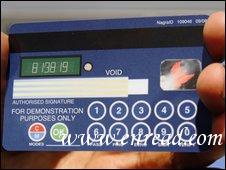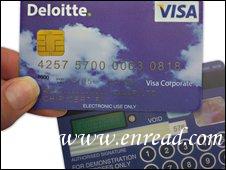| ||||||||||||||||||||||||||||||||||||||||||||||||||||||||
|
A credit card with a built-in display is being tested by Visa with the aim of reducing online fraud. Visa正在测试具有内置显示的信用卡,意在减少网络犯罪率。 The new code technology could reduce so-called 'card not present' fraud The Emue Card generates and displays a unique code each time it is used. Developers say that the new technology would make it very hard for fraudsters, as any transaction would require the pin to generate the code. The card is currently being trialled(尝试 ,试验) by 500 employees of Deloitte with the aim of assessing the technology by the end of the year. The new technology comes against a growing backdrop of fraud(欺骗,诈骗). While chip and pin technology has helped reduce crime at the tills, when it comes to phone, internet, and mail order fraud - known in the industry as card-not-present or CNP fraud - the figures are growing every year and now make up more than 50% of all credit card fraud. These transactions ask for the 16-digit1 code on the front of the card, and expiry date(有效日期) and some also ask for the three digit security card on the back. All of these details are available to a criminal who has a stolen card. According to figures from the Association for Payment Clearing Services (Apacs) - the trade forum2 for banks, building societies, and credit card firms - CNP fraud accounted for more than £328.4 million in 2008, a rise of 13% from the previous year. Michelle Whiteman, a spokesperson for Apacs, said there were a number of problems in tackling CNP fraud. "Firstly, you aren't able to check the card's physical security measures, such as the hologram(全息图) or signature. "Then, at present, there is no form of chip and pin security. "And finally, because of the anonymous3 nature of internet transactions(会报), there fraudsters have a much lower chance of getting caught, which probably encourages some people who might otherwise not commit a crime," she said. Visa say the new Emue system could help combat this by adding an additional layer of security. While the three-figure security code would remain, an additional four figure code - generated by the card - would also be required before a transaction could go through. The new Emue card is currently on trial with Deloitte employees Sandra Alzetta, head of innovation at Visa, said that the card was bringing the principles of chip and pin technology to the online world. "The card needs to be globally compatible: that means embossed characters for mechanical swipes, a magnetic(磁条) strip for systems that require a signature, the fixed5 three digit security code and now the unique four figure code. "You have to remember that our cards work across the world and not every country or retailer6 has access to the level of technology we might be used to," she said. Ms Alzetta said she hoped field trials would be completed by the end of the year. Once certified7 by Visa it is then down to the banks and credit card companies to decide if they take up the new technology, but Ms Alzetta said she was confident they would. "I see this as a very consumer focused product and any Visa bank could add it to their commercial cards and make it available, assuming it passes muster(召集,点阅)." One of the problems facing developers was how to make sure the card could be handled like any other card without accidently pressing buttons or breaking the display. "We've made the buttons in such a way that you need to 'pinch' them, rather than just press, for them to work. "One of the things we're testing is how long the battery lasts - the plan is for it to work for more than three years, which means your card should expire before it runs out of power." 点击  收听单词发音 收听单词发音
|
||||||||||||||||||||||||||||||||||||||||||||||||||||||||
- 发表评论
-
- 最新评论 进入详细评论页>>





